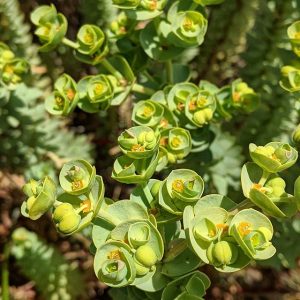Sea Spurge (Euphorbia paralias), a Mediterranean spurge introduced to Australian coasts and now actively transforming dune environments around the continent’s southern perimeter. Sea Spurge alters dune morphology, vegetates areas of dune sand that formerly lacked cover, and furthers the depletion of areas suitable for Hooded Plover nesting.
Although an older record has been suggested (Heyligers 1985) from Albany in WA (1927), the first digitised record for Sea Spurge in Australia was made in SA in 1934, near Port Victoria on the Yorke Peninsula. Port Victoria operated as a grain jetty until the end of the 1940s, when the use of windjammer sailing ships in the international grain trade was finally discontinued. It is likely that Sea Spurge arrived in Australia in dumped ballast carried from England and Ireland by these late commercial sailing ships. The species was collected at Bremer Bay in WA in 1944, and in Victoria at Portland in 1957.
Since that time, Sea Spurge has conducted a relentless coastal march. Once the first Australian beachheads had been established, dispersal of seeds and root fragments by wave action, ocean currents and mechanical contamination meant that it was only a matter of time before the plant became widespread. The first collections from the greater vicinity of Port Phillip Bay were made in 1985 at Ocean Grove, and then in 1994 at Flinders Ocean Beach. It has been recorded inside the bay only very recently, with collections or reports of small numbers of plants made at Seaford, Black Rock, Rye and Indented Head.
The photographed plants are not metropolitan specimens, but were instead sighted on beaches east of Cape Otway where they are densely established.
View Original Post on Instagram
Search for information about Euphorbia paralias in the Flora of Victoria
View information and occurrences of Euphorbia paralias on the Atlas of Living Australia











